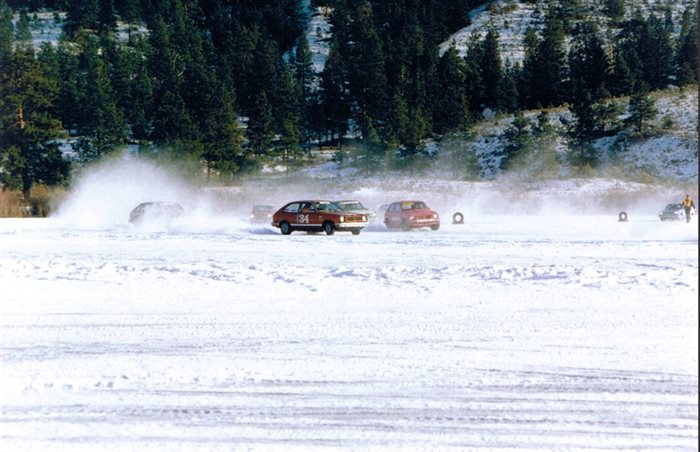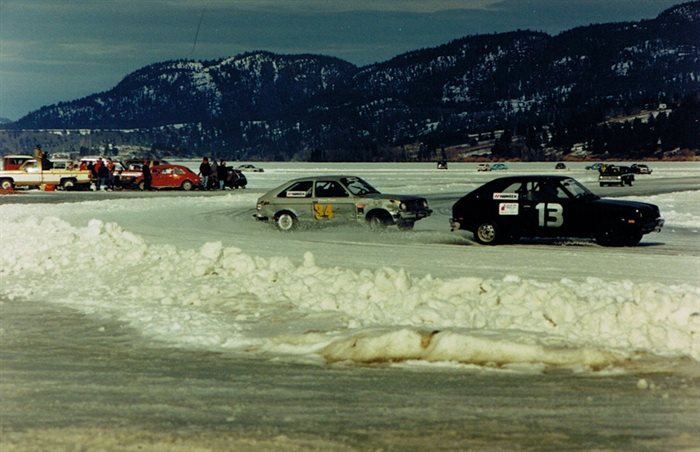Why there’s no longer ice racing on Duck Lake in the Okanagan
As Okanagan Valley lakes go, Duck Lake is not one of the biggest or better known.
But a decade ago, the 7 km long lake next to Highway 97 between Kelowna Airport and Lake Country, was alive many winter Sundays with racing cars.
“We used to have massive races,” Darren Turner, one of the racers back in the day told iNFOnews.ca. “There were big groups of 40 cars altogether. It was a huge thing with spectators and everything.”
He started racing on the lake in about 1988 and ran his last ice race on Swan Lake during the Vernon Winter Carnival, which may have been in 2011.
READ MORE: Blast from the past: When ice racing was a staple at Vernon's Winter Carnival
It’s unclear when ice racing began in B.C. but it may have started about 1972 when a group of race enthusiasts came up with the idea and determined that the Thompson/Okanagan region would be the best place.
They soon called themselves Cars on Ice – Western Canadian Ice Racing Association of B.C. and started holding two-day events on Barnes Lake near Ashcroft.
That continues today with Icex (single car timed events) scheduled for this weekend (Jan. 14 and 15) and Feb. 11-12.
In its heyday it drew up to 80 racers on a weekend.
But that’s a different type of racing than the Duck Lake event, which is called wheel-to-wheel racing.
That means a couple dozen cars racing against each other around a 2 km curving course where speeds on the straight-away could reach 100 km/h.
What really made the sport take off on Duck Lake was the introduction of a Chevette class of races, which the Kelowna group seems to have pioneered.
The cars were built by Chevrolet from 1976-87 and turned out to be ideal for ice racing.
“Those cars, although they’re not really dynamite on the pavement, they’re really fun on ice,” Turner said. “They’re really well balanced. You can slide them around really well so they were a fun car to play with on the ice.”
They were also cheap, costing about $500. Safety equipment like roll cages, would cost more than the cars.
No modifications were allowed to the Chevettes and everyone had to run with the same studded tires.
That meant the cars were street legal.
“A lot plated them and drove them to the race track and put their racing tires in the hatch in the back of the car and changed their tires when they got to the track,” Turner said.
Since the cars were basically all the same in design and power, it took real skill to win a race.
“When you’ve got a slippery surface, the driver plays into it quite a bit but it’s also the preparation of the car,” Turner said. “You’ve got to keep it in very good condition as well as taking good care of your tires.”
He’s done a lot of racing on asphalt and has competed professionally on the precursor to the Canadian NASCAR circuit.
Racing on ice is definitely different than racing powerful stock cars on asphalt.
“It’s all racing to me,” Turner said. “The sensation of speed is maybe not quite as dramatic on the ice. One big thing is the patience required and to slide the car correctly. Sliding it and not going fast is easy. Sliding it and still going fast is a huge challenge and a great way to build skills to always be sideways. You would always have to manage traction – sideways, forward, back. It kind of exaggerates everything you do on pavement racing. Everything requires that much more finesse and patience on ice. I attribute a lot of success I’ve had to ice racing. All the knowledge transfers.”
But, by the late 90s or early 2000s, the sport faded away.
READ MORE: iN PHOTOS: The lost speedways of the Thompson-Okanagan
“I think a lot of people want to say it’s something to do with the climate that we don’t race anymore,” Turner said. “I don’t really think that’s true. We had a lot of problems back then with ice too. It was more because the effort that is required is quite significant. People got to the point in their lives where they moved on to other things, or in some cases people got a little older and the baton didn’t quite get handed on, I guess.”
It took a huge effort by a relatively small number of dedicated people to make the races happen.
Key to it was the need to keep the track plowed. If the snow was left to accumulate too much, it was impossible to move.
That meant people had to go out in the middle of the night to clear the ice. That also helped the cold penetrate deeper into the lake and made the ice thicker.
Rules had to be written and the races were officially sanctioned through a national race association. Drivers had to have competition licences and the races had to be insured.
Safety was a big issue so care was taken to make sure the ice was thick enough for racing.
Turner knows of no case where a competition vehicle ever went through the ice. The same is not true of the plow trucks, with a couple of them breaking through the ice.
They were always recovered.
“One time a helicopter was involved,” Turner said. “That one was expensive.”
The plan was to run six or seven races every second Sunday starting in early January. But, even back then, the ice did not cooperate and that race schedule sometimes got shortened to seven weeks.
Once they ran races on Wood Lake but, in warmer years, they went to Idabel Lake and once to Beaver Lake. Track plowing and participation was difficult that far away.
“Duck Lake was perfect,” Turner said. “It’s pretty close to town and everybody’s home in 20 minutes so, of course, we would want to be there. The reason we started going to Idabel Lake in the 90s is because Duck Lake wasn’t freezing for a couple of years.”
He believes ice racing is still feasible despite a warming climate.
“There’s lots of ice,” Turner said “It’s certainly still doable. But you have to make an effort.”
To learn more about Dave Turner and his racing career, go here.
To contact a reporter for this story, email Rob Munro or call 250-808-0143 or email the editor. You can also submit photos, videos or news tips to the newsroom and be entered to win a monthly prize draw.
We welcome your comments and opinions on our stories but play nice. We won't censor or delete comments unless they contain off-topic statements or links, unnecessary vulgarity, false facts, spam or obviously fake profiles. If you have any concerns about what you see in comments, email the editor in the link above.







